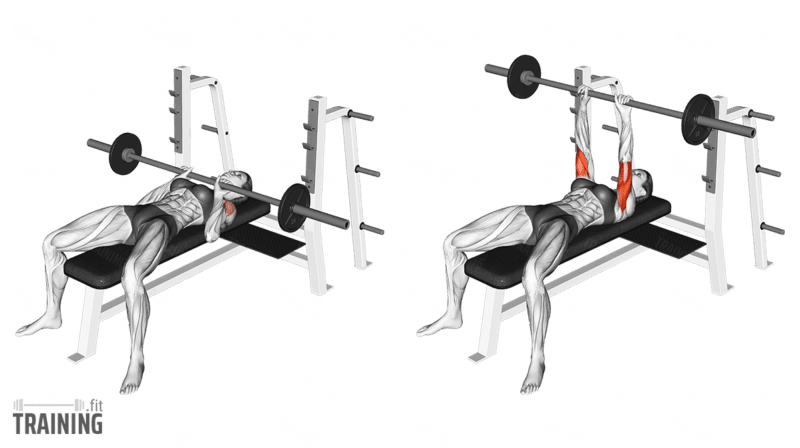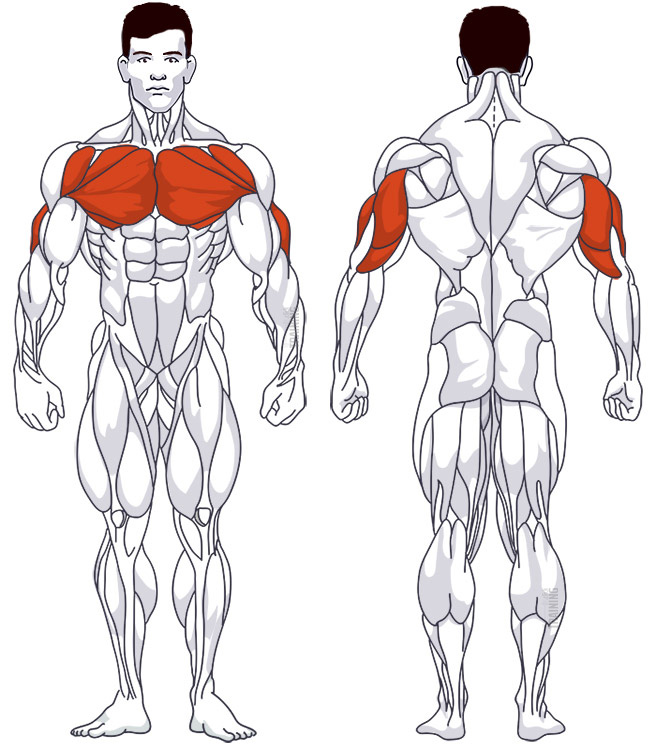Close-Grip Bench Press
Compound exercise, Free weightsOverview

Main muscles
- Chest: Large pectoral muscle
(Musculus pectoralis major) - Shoulder: Anterior deltoid muscle
(Musculus deltoideus, Pars clavicularis) - Triceps: Three-headed arm muscle
(Musculus triceps brachii)
Training plans
Here you can find example plans for close-grip bench press training:
Close-Grip Bench Press: Basics and alternatives

Involved main muscle groups:
Close-Grip Bench Press
The close-grip bench press is a variation of the standard barbell bench press. In this exercise, you focus more on your triceps because of the closer grip width. The movement remains the same: you lie on your back on a flat bench and move a barbell up and down by bending and extending your arms.
Unlike many other tricep exercises, the close-grip bench press is a compound exercise, not an isolation exercise. It works your chest and front shoulders, activating multiple muscle groups at once. Another compound exercise you can try is dips.
If you’d rather isolate your triceps, consider kickbacks or cable tricep pushdowns.
Correct execution
There’s no strict rule for how narrow your grip should be. Many beginners start with a very narrow grip, sometimes even touching hands. However, for stability reasons, it’s best to avoid this. A grip that’s too close can cause wrist pain, limit your range of motion, and reduce training effectiveness.
A good rule of thumb is to keep your grip width around shoulder width. In a regular flat bench press, your grip would be slightly wider than shoulder width.
When lowering the barbell during the close-grip bench press, you’ll notice it lands slightly lower on your body compared to a standard bench press. That’s okay; the barbell doesn’t have to touch the same spot as it does during a normal flat bench press.
Your elbow position will also change with the narrower grip. Keep your elbows from flaring out too much or pressing too close to your body, as both can stress your shoulders.
Video tutorial
Step-by-step instructions
Lie down on your back on the flat bench. The barbell in the rack should be at eye level.
Place your feet firmly on the ground. Don’t lift them like you sometimes see in the gym. You’ll achieve the best stability with your feet on the ground.
Pull your shoulder blades back.
Tighten your lower back and create a slight arch. Press your upper back into the flat bench to form the “bridge.”
Extend your arms straight up and grip the barbell about shoulder width apart.
For safety, make sure your thumb grips the bar too.
Lift the barbell out of the rack.
Lower the bar evenly and in a controlled manner above your chest. Don’t flare your elbows out too much or press them too close to your body. Find a neutral elbow position that doesn’t cause pain.
Keep your shoulder blades tucked in while lowering and breathe in.
The barbell might end up lower than usual due to the narrow grip. That’s fine. Ensure your posture feels natural and pain-free when lowering the bar.
Perform the upward movement quickly but with proper form. Exhale as you do so.
At the top, maintain body tension, don’t fully extend your arms, and repeat the movement.
Common mistakes and injuries
It may seem obvious, but it’s worth mentioning: adjust your training weight to match the close-grip width. Since the close-grip bench press relies more on your triceps, you’ll use less weight than with the standard bench press. Keep this in mind and reduce the weight accordingly.
Also, ensure you have a secure grip by gripping the bar with your thumb (closed grip). Don’t use the monkey grip (open grip), where the thumb is next to the other fingers. When gripping the bar, your thumb acts as a safety measure against accidental roll-off. So, it’s crucial to grip the bar properly. This is even more important with the narrow grip, as it’s less stable than a wider grip.
If possible, perform the exercise with a spotter or use safety bars in a power rack.
Other than that, follow the same rules as for the standard bench press. Keep your shoulder blades pulled back, form a slight arch in your back, and don’t flare your elbows too far out.
Lower the weight in a controlled manner and avoid bouncing it off your body.